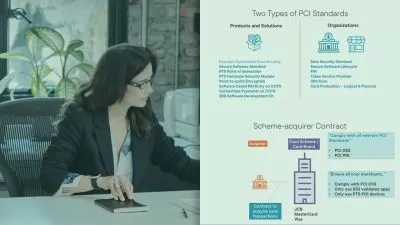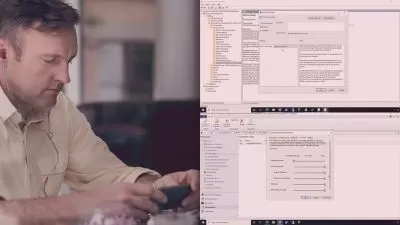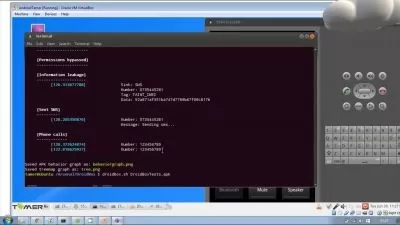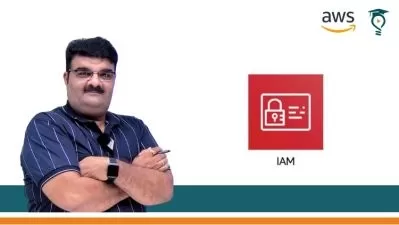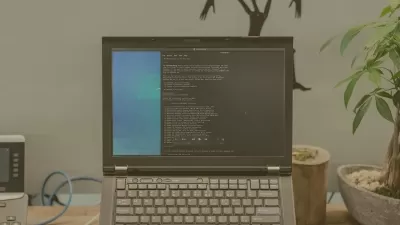Mastering Reverse Engineering & Malware Analysis | REMASM+
OCSALY Academy | 160.000+ Students
10:48:18
Description
Master Reverse Engineering, Malware Analysis, Linux, Cyber Security, Ghidra,x86-64, IDA Pro, IDA Free, Assembly and NASM
What You'll Learn?
- The theory behind disassembly and its role in reverse engineering.
- The four stages of binary analysis: Preprocessing, Compilation, Assembly, and Linking.
- The compilation process breakdown and the purpose of each phase.
- Working with symbolic information in stripped and not stripped binaries.
- How binary executables load and execute.
- Installation and basics of Ghidra, a tool for reverse engineering.
- Installing the Java Development Kit (JDK) for Ghidra.
- Navigating and utilizing Ghidra for project analysis.
- Real-world malware analysis using Ghidra.
- Practical reverse engineering skills through hands-on malware analysis.
- Writing a 64-bit assembly program to display "Hello, world!" using a makefile.
- Installing and setting up the SASM assembler for assembly programming.
- Understanding the superiority of NASM (Netwide Assembler) and comparing it with other assemblers.
- Creating a basic "Hello, world!" program in assembly without using a makefile.
- Exploring the theory of disassembly and disassemblers in reverse engineering.
- Analyzing the fundamentals of disassembly and its importance in reverse engineering.
- Delving into various data types and their representation in assembly language.
- Understanding CPU architectures, binary files, and their relationship.
- Converting decimal numbers to binary using basic mathematical operations in assembly.
- Initiating debugging with gdb (GNU Debugger) and configuring debugging flavors.
- Debugging techniques for locating and inspecting variables in memory addresses.
- Expanding knowledge of gdb functionalities for advanced debugging scenarios.
- Writing a second 64-bit assembly program, creating the source code, and generating a makefile.
- Analyzing program output using gdb and building a makefile for the assembly code.
- Exploring binary analysis and comprehending the four stages of compilation.
- Learning about preprocessing, compilation, assembly, and linking phases of program compilation.
- Distinguishing between symbols, stripped, and non-stripped binaries.
- Utilizing READELF to view symbolic information in binaries and object files.
- Revealing the contents of an object file and attempting to analyze binary executables.
- Understanding how binary files load and execute in theory.
- Exploring the Executable and Linkable Format (ELF) used in Linux executables, focusing on the executable header.
- Learning about ELF fields and ELF program header fields.
- Understanding the fundamentals of Windows PE (Portable Executable) format used in Windows executables.
- Mastering bitwise logical operations: OR, XOR, NOT, and AND.
- Applying OR logic to manipulate data and perform bitwise operations.
- Implementing NOT logic to invert bits in assembly programming.
- Exploring XOR logic and its applications in data manipulation.
- Understanding AND logic and how it's used for masking and bit filtering.
- Utilizing the Data Display Debugger (DDD) to analyze assembly programs.
- Developing assembly programs to analyze using DDD and understanding the debugging process.
- Analyzing RAX register values using DDD and gdb.
- Mastering control flow with jump and loop instructions in assembly.
- Learning about common errors in assembly programming and their solutions.
- Using conditional statements and jumps to control program flow.
- Implementing jump instructions based on equality conditions.
- Understanding jump instructions for inequality conditions.
- Employing jump instructions for comparisons involving greater values.
- Implementing jump instructions for greater-than-or-equal-to conditions.
- Using jump instructions for comparisons involving lesser values.
- Implementing jump instructions for less-than-or-equal-to conditions.
- Developing an assembly project that utilizes jump and loop instructions effectively.
- Creating a calculator project using assembly language to perform arithmetic operations.
- Defining variables and memory allocation in assembly programming.
- Implementing addition and subtraction operations in assembly language.
- Adding final touches and decorations to assembly projects.
- Explaining the practical usage of registers in assembly programming.
- Completing the assembly projects with a focus on optimization and efficiency.
- Utilizing memory manipulation techniques to interact with data structures.
- Exploring a more advanced project called "EXABYTE" involving memory manipulation.
- Testing and analyzing projects using tools like Readelf and GDB for verification and debugging.
Who is this for?
What You Need to Know?
More details
DescriptionWelcome to a best online learning experience that delves deep into the fascinating world of reverse engineering and malware analysis.
In this comprehensive course, you'll embark on a journey that unravels the complexities of software, empowering you to decode its inner workings, uncover vulnerabilities, and fortify digital defenses. Join us in "Mastering Reverse Engineering and Malware Analysis" to acquire the skills needed to navigate the digital landscape with confidence and expertise.
Discover the Essence of Reverse Engineering and Malware Analysis
Reverse engineering is the intricate process of dissecting software and systems to understand their architecture and functionality. It involves peeling back the layers of code to uncover hidden intricacies, enabling you to comprehend how software operates, regardless of whether it was originally developed by you or others. This skill empowers you to identify vulnerabilities, optimize performance, and enhance software security.
Malware analysis, a crucial facet of cybersecurity, is the art of dissecting malicious software to understand its behavior, intent, and potential impact. By analyzing malware, experts gain insights into the techniques employed by cybercriminals, enabling them to develop effective countermeasures and safeguard digital assets. Understanding malware analysis equips you to identify, neutralize, and prevent cyber threats, making it an essential skill in today's interconnected world.
Why is Reverse Engineering and Malware Analysis Essential?
In the digital age, where technology governs every facet of our lives, the significance of reverse engineering and malware analysis cannot be overstated. Here's why mastering these skills is paramount:
              1. Digital Defense Mastery:
The cyber landscape is riddled with threats, from sophisticated malware to intricate hacking techniques. By mastering reverse engineering and malware analysis, you empower yourself to uncover vulnerabilities and proactively defend against potential attacks. Your ability to dissect and understand malicious code allows you to devise robust countermeasures that thwart cybercriminals' efforts.
              2. Innovate with Confidence:
Reverse engineering transcends mere analysis; it's also a tool for innovation. By studying existing software, you can extract insights, identify best practices, and develop enhanced versions or entirely new solutions. This process enables you to create innovative software, saving time and effort by building upon existing foundations.
              3. Strengthen Software Security:
Malware analysis is your armor against cyber threats. As cybercriminals devise increasingly sophisticated attacks, understanding their tactics is crucial for developing effective defense mechanisms. By studying malware behavior, you gain the insights needed to prevent future threats, ensuring the safety of sensitive data and digital operations.
              4. Unlock Career Opportunities:
In the ever-evolving landscape of technology, professionals with reverse engineering and malware analysis skills are in high demand. Organizations across industries seek experts who can safeguard their digital assets, analyze software for vulnerabilities, and contribute to the development of secure, cutting-edge solutions. Mastering these skills opens doors to lucrative career opportunities in cybersecurity, software development, and more.
              5. Empower Ethical Hacking:
Ethical hacking leverages the knowledge gained from reverse engineering to identify vulnerabilities in systems and networks. This practice helps organizations identify weak points before malicious actors exploit them. By mastering reverse engineering, you become an asset in ethical hacking, contributing to the protection of digital infrastructure.
              Experience the Power of Mastery
Embrace the transformative journey of "Mastering Reverse Engineering and Malware Analysis." This course isn't just about acquiring skills; it's about unlocking a world of possibilities. From deciphering complex software to safeguarding digital assets and innovating with confidence, you'll gain the expertise needed to excel in the realm of technology. Join us and become a digital guardian, equipped to decode, defend, and drive progress in the digital age. Enroll today to step into a realm where knowledge empowers, and possibilities are limitless.
Who this course is for:
- For everyone who wants to learn reverse engineering
Welcome to a best online learning experience that delves deep into the fascinating world of reverse engineering and malware analysis.
In this comprehensive course, you'll embark on a journey that unravels the complexities of software, empowering you to decode its inner workings, uncover vulnerabilities, and fortify digital defenses. Join us in "Mastering Reverse Engineering and Malware Analysis" to acquire the skills needed to navigate the digital landscape with confidence and expertise.
Discover the Essence of Reverse Engineering and Malware Analysis
Reverse engineering is the intricate process of dissecting software and systems to understand their architecture and functionality. It involves peeling back the layers of code to uncover hidden intricacies, enabling you to comprehend how software operates, regardless of whether it was originally developed by you or others. This skill empowers you to identify vulnerabilities, optimize performance, and enhance software security.
Malware analysis, a crucial facet of cybersecurity, is the art of dissecting malicious software to understand its behavior, intent, and potential impact. By analyzing malware, experts gain insights into the techniques employed by cybercriminals, enabling them to develop effective countermeasures and safeguard digital assets. Understanding malware analysis equips you to identify, neutralize, and prevent cyber threats, making it an essential skill in today's interconnected world.
Why is Reverse Engineering and Malware Analysis Essential?
In the digital age, where technology governs every facet of our lives, the significance of reverse engineering and malware analysis cannot be overstated. Here's why mastering these skills is paramount:
              1. Digital Defense Mastery:
The cyber landscape is riddled with threats, from sophisticated malware to intricate hacking techniques. By mastering reverse engineering and malware analysis, you empower yourself to uncover vulnerabilities and proactively defend against potential attacks. Your ability to dissect and understand malicious code allows you to devise robust countermeasures that thwart cybercriminals' efforts.
              2. Innovate with Confidence:
Reverse engineering transcends mere analysis; it's also a tool for innovation. By studying existing software, you can extract insights, identify best practices, and develop enhanced versions or entirely new solutions. This process enables you to create innovative software, saving time and effort by building upon existing foundations.
              3. Strengthen Software Security:
Malware analysis is your armor against cyber threats. As cybercriminals devise increasingly sophisticated attacks, understanding their tactics is crucial for developing effective defense mechanisms. By studying malware behavior, you gain the insights needed to prevent future threats, ensuring the safety of sensitive data and digital operations.
              4. Unlock Career Opportunities:
In the ever-evolving landscape of technology, professionals with reverse engineering and malware analysis skills are in high demand. Organizations across industries seek experts who can safeguard their digital assets, analyze software for vulnerabilities, and contribute to the development of secure, cutting-edge solutions. Mastering these skills opens doors to lucrative career opportunities in cybersecurity, software development, and more.
              5. Empower Ethical Hacking:
Ethical hacking leverages the knowledge gained from reverse engineering to identify vulnerabilities in systems and networks. This practice helps organizations identify weak points before malicious actors exploit them. By mastering reverse engineering, you become an asset in ethical hacking, contributing to the protection of digital infrastructure.
              Experience the Power of Mastery
Embrace the transformative journey of "Mastering Reverse Engineering and Malware Analysis." This course isn't just about acquiring skills; it's about unlocking a world of possibilities. From deciphering complex software to safeguarding digital assets and innovating with confidence, you'll gain the expertise needed to excel in the realm of technology. Join us and become a digital guardian, equipped to decode, defend, and drive progress in the digital age. Enroll today to step into a realm where knowledge empowers, and possibilities are limitless.
Who this course is for:
- For everyone who wants to learn reverse engineering
User Reviews
Rating
OCSALY Academy | 160.000+ Students
Instructor's Courses
Udemy
View courses Udemy- language english
- Training sessions 67
- duration 10:48:18
- Release Date 2023/09/10








